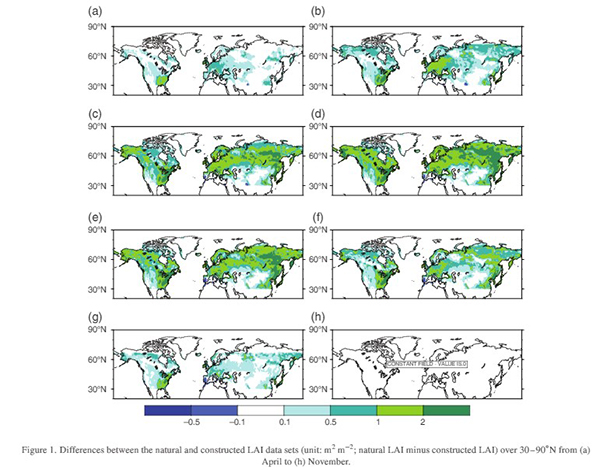最新科研进展
Influences of the Seasonal Growth of Vegetation on Surface Energy Budgets over Middle to High Latitudes
Authors:
Zhu Jiawen1 and Zeng Xiaodong1,2
1 International Center for Climate and Environment Sciences, Institute of Atmospheric Physics, Chinese Academy of Sciences, Beijing, 100029, China;
2 Collaborative Innovation Center on Forecast and Evaluation of Meteorological Disasters, Nanjing University of Information Science & Technology, Nanjing, 210044, China
Abstract:
The feedbacks of vegetation growth to climate are very important and exhibit large differences, depending on seasons and characteristics of plants and climate. Through two simulations, this work investigated these differences among the influences of the seasonal growth of different vegetation on surface energy budgets over the latitudinal range of 30–90°N and detected associated causes. The seasonal growth of vegetation is expressed as an increase in leaf area index (LAI) during the growing season (April to October) compared to boreal winter (December–January–February). The results showed that notable effects occurred in latent heat flux, downward solar radiation and reflected solar radiation for dominant plant functional types (PFTs). With a seasonal increase in LAI, the latent heat flux of ‘needleleaf evergreen boreal tree’ (NEB) decreased, while it increased for the other dominant PFTs. Such unexpected behaviors of NEB were mainly contributed by the weak changes in its transpiration, which was associated to land-atmosphere feedbacks (the decreased downward solar radiation) and competitions among PFTs (the intensified transpirations of the deciduous vegetation PFTs). Surface downward solar radiation decreased for all dominant vegetation PFTs because of more low clouds. The reflected solar radiation of ’broadleaf deciduous temperate tree’ increased along with increased LAI because its leaf albedo is higher than that of the background soil, and the reflected solar radiation of ’broadleaf deciduous boreal shrub’ drastically decreased during April and May, which resulted from its interactions with accumulated snow. This paper sufficiently proves that the feedbacks of different vegetation to surface energy balance could vary widely, not only in magnitudes but also in directions. Therefore, it is very important to accurately parameterize vegetation phenology and optical properties for a better representation of vegetation-climate interactions.
Key words:
seasonal growth of vegetation; leaf area index; surface energy balance; land-atmosphere interaction

Citation:
Zhu, J. W., and X. D. Zeng, 2017: Influences of the seasonal growth of vegetation on surface energy budgets over middle to high latitudes. Int. J. Climatol., 37, 4251-4260.
